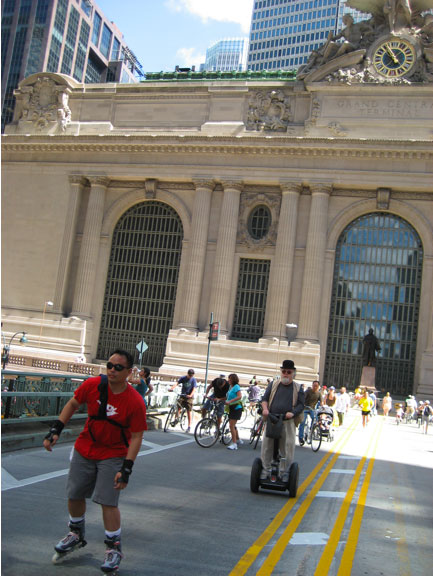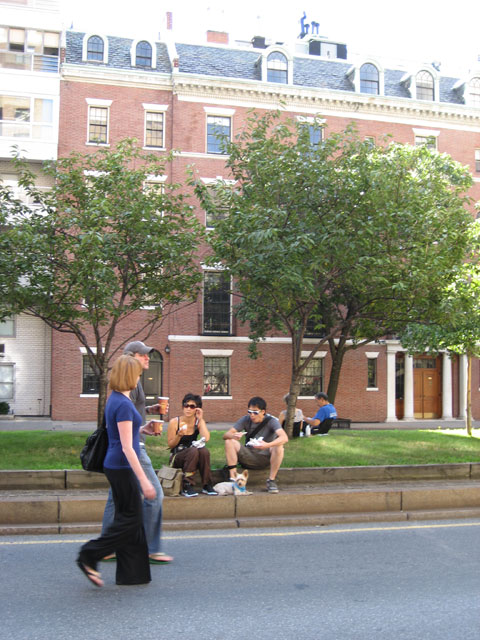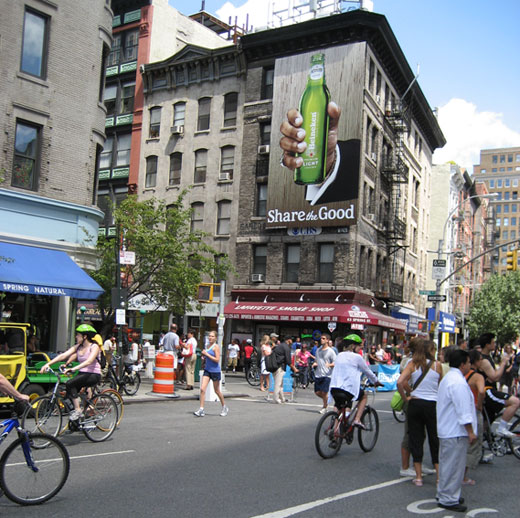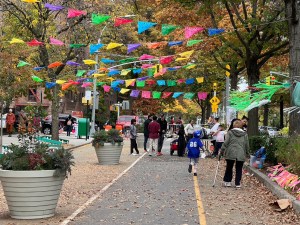Summer Streets: Bikes and Pedestrians Get Along Fine Without Cars
We excerpted this essay from reader Jen Petersen to lead off our first Summer Streets photo gallery yesterday afternoon. Her full account follows.
If New York City’s inaugural Summer Streets event on August 9th was any indication, it seems that bikes and pedestrians do just fine without cars. Here’s why, as observed from the seat of a peregrinating pedicab:

1) With cars completely off the route, cyclists, walkers, runners, skaters, rollerbladers, and ‘others’ (see above) had plenty of space. Instead of our normal elbow-to-elbow jostle for the scraps of an automobile-packed Avenue, we spread out over all the traffic and parking lanes, and found that when we’ve got room, we do pretty well together. A Park Avenue ‘for’ cars means the less prioritized modes are unfairly pit against each other in a sort of low stakes turf war. But at Summer Streets, there was no need to squabble over the scraps.

2) We could talk and listen to each other. Without automobile engines idling, anxious drivers honking, and bus air brakes squealing, it was breathtakingly quiet. People on bikes, foot, rollerblades, skateboards, and ‘other’ wheels, could actually hear things, including each other. And so more than once, approaching a clump of moseying pedestrians from behind, I would make the quick calculation that my four foot-wide pedicab would certainly not fit around them, and gently tap my bell (it was so quiet, ginger signaling would do just fine), slow down a bit, and say in a cheery voice: "Coming around you!" And I was also free to strike up conversations with all sorts of strangers, and not just ones on bikes! Imagine how city streets would feel with more people talking to each other, and not shouting at each other.

3) When cars and bikes share the road, the expectation is that bicycles behave more like cars, since most New York City streets have been engineered for automobility. Except on roads with special accommodations for bikes, such as the separated cycle track on 9th Avenue between 23rd and 14th streets in Manhattan, the path of least resistance for urban cyclists is the one of automobile avoidance. Sometimes cyclists avoid cars by using shared bike/pedestrian paths (such as the Hudson River Greenway), but these are in precious short supply. Many cyclists instead avoid cars by grasping handlebars tightly, eyes fixed on the road ahead, and attempt to ‘keep up’ with the dictates of automobile-sped traffic. We avoid injury by girding up as for battle against possible encroachments by cars and pedestrians. But an unfortunate side-effect of this defensive driving–type strategy is that cyclists can displace their automobile-spun mistrust onto even the most obediently flow-maintaining pedestrians, who are by now well-trained to leap out of harm’s way from the threatening cyclist bearing down.
Bike travel as battle is automobile-reactive, and when cyclists let the tempo of automobile time/space rhythms become their own cadence, we can easily let the humanity drop out of our commutes. In suddenly humane Summer Streets, pedestrians and cyclists were free to enjoy each other’s compatibly human paces! And so…

4) We choreographed impromptu dance steps! According to some, Lafayette Street and Park Avenue are tragically design-flawed for the occasion. I mean, we’re a first-rate city, so oughtn’t we have Class ‘A’ improved bike/pedway for such a demonstration of urban space for people? Isn’t anything less terribly dangerous and isn’t the city putting us all at risk by opening up an unscripted ribbon of roadway to rag tag multi-modals like us?
No way!
In the absence of special pavement markings delineating lanes for walkers, runners, cyclists, rollerbladers/skaters, people with children (and strollers), and others, we had to be responsible for our footprints. The burden of regulating our interactions and avoiding altercations was on us; NYPD was only keeping the current conflict-free where it met automobiles at transverse streets. And so it seems when we travel at more or less the same speed, and the journey is itself the destination, we somehow figure out how to use each other as signposts. Now if we could just figure this out on a workday, in all five boroughs…
